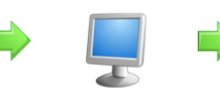We live in a world where technology has infiltrated every aspect of our lives. The world is moving towards a more connected and streamlined system with intelligent assistants and sophisticated digital technology. Yet, despite all of these developments, most businesses still use far too much paper in their day-to-day operations. While it’s not possible to eliminate paper completely, you can reduce consumption by a significant margin if you plan well.
Some businesses are reluctant to move to archiving and digital records because they are concerned about security. They fail to understand the true cost of paper and how much of an impact it can have on the bottom line of their business.
What are the True Costs of Paper?
Everyone knows that excessive paper consumption can be harmful to the environment. Companies that want to turn to green practices have already started to archive their files and turn digital. However, that’s not the only consequence of excessive paper consumption and here are some of them:
· $20 – Is the average cost of every document filed and it includes office supplies, storage, labor, and other such factors. If you file 100 documents in a week, you spend $2000 on it.
· 50% more Time – That’s how much you can potentially waste looking for new information according to Gartner Research.
· 18 Minutes on Average – That’s how long it takes for a person to find information stored in paper documents.
· $120 on Average – Companies pay this amount for every misfiled document.
· $220 – Is the cost of lost documents, which are quite expensive to recreate and file once again.
· 20% – Is the average percentage of misfiles by companies in America.
· $14,000 – Is the average loss of productivity every year for every employee. They are forced to waste time and energy trying to find information stored in these documents and that has an impact on their productivity.
· $700,000 – That’s how much Citigroup projected it would save if every employee saved one piece of paper every week for a year.
· $25,000 – The cost of labor required to fill a standard four-drawer cabinet full of documents.
· $2,000 – The cost of maintenance for the aforementioned drawer cabinet.
As you can see, documents and physical paperwork can be very expensive in the long run. If you switch to digital documentation and archiving systems, you’ll increase productivity, save space, save money, and enjoy several other benefits.
How to Go Paperless?
As mentioned before, it’s not possible to go completely paperless because some documents require signatures, thumb impressions, etc. However, that doesn’t mean that you can’t turn most of your documents digital. Here’s how you can achieve that result:
· Identify – The first step is to determine which documents can be digital. Separate all of your files into two categories; one that includes paperwork you need physical copies of and the other that includes paperwork that can be digitized. Some companies process a massive amount of legal and formal paperwork that needs to be stored in physical form while others can turn nearly 90% of their documentation into digital copies.
· Develop a Strategy – Once you have identified the two categories, you need to implement the new digital system. This isn’t easy and will require cooperation from your employees. Before you implement the system, explain it to your employees. They should know how the system works and which of the documents they should keep physical copies of. Good training will minimize the potential cost and reduce mistakes.
· Develop a Good System – An easy-to-use system is the best way to ensure that your employees accept the change. The last thing you want is to add to their burden and hamper their productivity. Create an online system where your employees can enter information easily and quickly. If you keep the system in cloud, it will be accessible to employees even when there’s not on company premises. This can help if there are deadlines and mistakes. The employee doesn’t need to travel to work to correct the error or update the documents.
· Pay Attention to Storage – You need a secure document storage system that will keep all your files in one place and ensure they’re organized. You can store them in cloud if you want to save some money but if you’re nervous about cloud system security, you can have a storage server on your company premises to ensure they can’t be access by unauthorized people. Cloud is a better option because service providers have complex security systems and encryptions in place. They’re also scalable and can easily grow with your company.
· Recycle – After you’ve created digital copies of your old documents, you need to discard physical files. The best way to do that is to shred them and send them off to recycling. You will help you environment if you do that.
Some companies hesitate to archive their paperwork because they’re intimidated by the volume. You can hire archiving companies to handle the job for you. We offer customized services that can suit your requirements and securely digitize all of your records. We will also make sure the physical copies are disposed of safely.
If you want to know more about the true cost of paper or our services here at Archiving Systems, feel free to call us on (956) 722 7853. You can also fill in the contact us form or email us at info@archiving-systems-inc.com.





